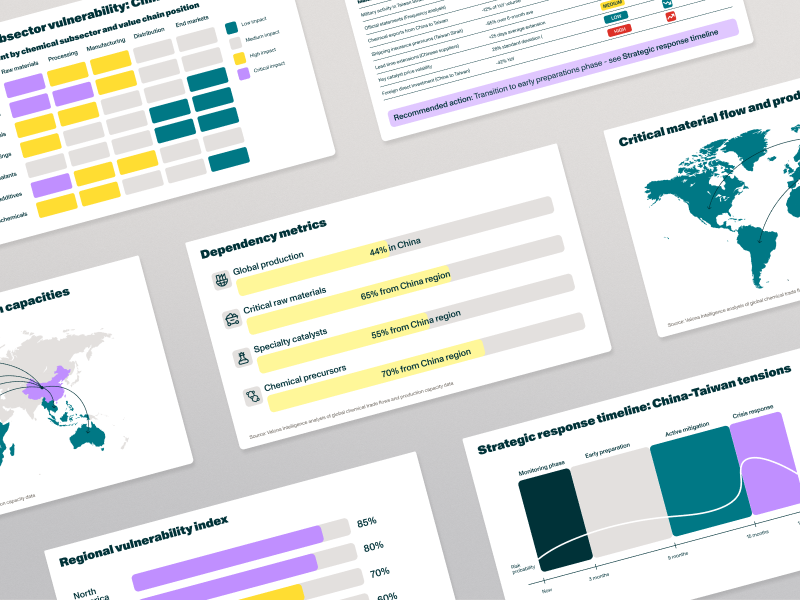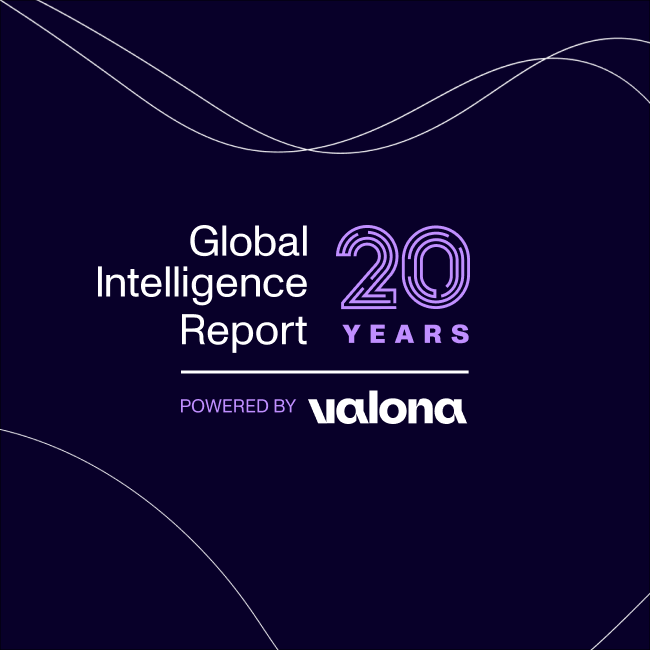
What is competitive intelligence? A practical guide
If you want to stay ahead of the competition, follow this practical and easy-to-follow guide to competitive intelligence.
Index
Introduction to competitive intelligence
Do you play chess? Let’s assume you do. Chess and competitive intelligence (CI) are a lot alike. Imagine you are in a high-stakes chess game. But you cannot see the chessboard. And you don’t see the other chess pieces either. Every move they make remains invisible to you.
While this is a rather bleak opening to this complete guide to competitive intelligence, it’s a metaphor that shows so well what it’s all about. Competitive intelligence, in its essence, makes the chessboard and the other players visible to you.
Gartner defines competitive intelligence (CI) as the analysis of an enterprise’s marketplace to understand what is happening, what will happen, and what it means to the enterprises operating in this market.
From a business perspective, CI can support different goals. The goals may be offensive, meaning they are about positioning the company in the marketplace, plotting a course for future positioning and allocating short – as well as long-term resources.
On the other hand, the goals can also be defensive, and CI is used to understand what kind of trends are sharpening the market—what is happening today and what may happen in the future. And how to best react.
In other words, CI is a key ingredient for businesses to make sense of the world around them and the different players within it. Once companies decide that they want to invest in CI, developing a well-rounded strategy spanning both competitive and market intelligence is key.
See also: competitor benchmarking, market attractiveness studies, using KPIs to measure insight success, competitor analysis tools.
This intelligence enables you to respond proactively and gain a strategic edge.
What is competitive intelligence?
Competitive intelligence is all the intelligence you may gather. It includes all relevant information that helps you create a thriving and competitive business in your market and build your strategy based on insights from, for example, your target customers, supply chain insights, and anything else that plays a role in your market.
CI is the collection, analysis, and utilization of information on your competitors and the market. This gives you a deep understanding of your rivals’ actions, strategies, strengths, and weaknesses. Having this intelligence helps you pinpoint threats and opportunities, helping you craft competitive strategies driven by data.
In a nutshell: competitive intelligence is the tool companies can use to understand the market they are operating in and gather data to make future predictions.
Why competitive intelligence?
Why do companies employ CI?
Data collected by CI analysis can help your business gain a significant edge by pinpointing and mitigating potential threats while identifying and seizing strategic opportunities to gain market share.
Here are three key reasons why competitive intelligence is important for a company’s strategy and business goals:
Strategic planning:
Competitive intelligence provides valuable insights into the market landscape, competitor activities, and industry trends. By analyzing this information, companies can make informed strategic decisions to capitalize on opportunities, mitigate risks, and stay ahead of the competition.
Operational efficiency:
By understanding the competitive environment, companies can optimize their operations, streamline processes, and allocate resources effectively. This not only enhances operational efficiency but also allows for proactive adjustments to adapt to market dynamics and competitors actions.
Business growth:
Competitive intelligence empowers companies to identify emerging trends, customer preferences, and potential opportunities for growth. By staying attuned to market changes and competitor strategies, companies can develop innovative products and services, enter new markets, and expand their market share to achieve their business goals, drive sustainable growth, and simply stay ahead of the competition.
Why is competitive intelligence so popular in today’s business environment?
The competitive landscape is more dynamic than ever, and the faster it develops, the more CI is moving to the center of businesses to ensure that they can maintain their competitive edge.
A few of the benefits enabled by effective competitor intelligence are:
- Fully understand how your competitors are performing and where their weak spots lie.
- Discover gaps in the market and keep track of new trends in your operating environment so you can be the first one to move.
- Find out how you can make improvements and use these insights for your brand strategy and marketing.
- Mitigate risk by constantly monitoring your competitors, which allows you to anticipate their next moves and helps your company set its strategy on solid ground.
- Strategic insights tell you exactly where you need to focus, so you don’t have to waste money on non-impactful measures.
- By understanding the forces that shape your market, be they competitors or new trends, you can generate new and innovative ideas for how to develop your business.
- By anticipating competitor moves, understanding market trends, and quickly identifying potential market disruptions, CI allows organizations to gain a much-needed and essential strategic edge.
Many markets are seeing increased competition with the emergence of new businesses and technologies, meaning that CI becomes an essential tool for organizations to remain ahead of the curve or to overtake more established competitors and gain increased market share.
What are the main components of competitive intelligence?
Now that we understand CI and why companies use it, what are the main components that comprise CI? What sources of CI are there, and how can you best gather CI?
Let’s find out.
Competitive intelligence analysis
CI analysis empowers businesses to refine their marketing strategies by understanding their place in the market compared to their competitors. This enhances their ability to identify and capitalize on opportunities, find gaps in the market to exploit, and increase their market share. The true power of CI, however, lies in its ability to provide means to foresee and react proactively to potential threats that are emerging in a given sector.
It’s not just about understanding what competitors do but combining insights into a unified platform to make as accurate as possible predictions about the future and predict risks and threats that may emerge and need to be mitigated.
This means that all the data that makes up the insights within a market will be collected in one place, making it possible to run accurate prediction models on it.
What are the methods of competitive intelligence?
Effective CI involves many methods for collecting data and insights into competitors’ activity. Traditional methods include competitor analysis, market research, and SWOT (strengths, weaknesses, opportunities, and threats) analysis, while more modern, cutting-edge methods include social media monitoring, scenario planning, and data mining.
These methods can be employed through human effort, although this can prove time-consuming and labor-intensive. As a result, more and more organizations are turning to automated CI methods with the assistance of AI and tools.
Valona’s unique approach to competitive intelligence uses generative AI to provide more significant insights from over 200,000 proprietary global source databases and categorizes these into competitive intelligence on one platform.
Competitive intelligence research
Effective CI involves exhaustive CI research to gain the best and broadest insights into your competitor’s strategies. To ensure you receive the best level of CI, you need to employ a robust competitive intelligence framework.
Begin by defining clear objectives for your CI, working out what you’re trying to understand, and identifying your closest competitors and market trends into which you want insight. Secondly, combining primary and secondary data sources can help mine information to gain as broad a perspective as possible on competitors’ activities, priorities, and market trends.
It’s not novel anymore to talk about tools with capabilities to run AI searches within relevant business insight sources; they have become a necessity due to the sheer volume and complexity of data available.
Traditional research methods are no longer sufficient to keep up with the rapid changes and high amounts of information. These AI-powered tools can quickly and accurately sift through large datasets, uncovering critical insights and trends that might otherwise be missed.
This is also where the Valona research app comes in, it is designed to gather the data to provide the best possible foundation for future analysis. Valona’s AI search capabilities stand out by integrating and analyzing data from over 200,000 global sources, including those hidden behind paywalls.
This advanced functionality ensures comprehensive and actionable insights, empowering businesses to stay ahead of the competition and make the best-informed decisions.
Arguably, the most important part of CI research is analyzing the information to ensure you can find the insights you need to help add value to your operations. Technology plays an increasingly prominent role in streamlining the process by automating manual tasks and enabling analysis of increasingly large datasets for more accurate, better-targeted insights.
How to gather competitive intelligence
So, once you’ve identified your CI objectives, key stakeholders and competitors, and data sources to provide your research, the question is how to gather competitive intelligence.
This involves selecting the right tools for the job. Only consider finding the right tool once you’ve identified your key objectives, as some packages on the market won’t suit your intelligence needs.
Once you know what your expectations from CI are, you can explore the tools on the market and select the best one to achieve these needs. Set a realistic budget and stick to it. Also, consider scalability if you want to increase your CI operations over time and whether the tool can integrate easily with your existing systems.
Finally, remember that focusing on less can provide you with more. The more refined your selection to the lowest number of tools means they’ll integrate more easily with data sources, helping to extract valuable insights that drive the best possible decision-making.
In addition, the fewer tools employees have to use, the easier it is to foster cross-team collaboration. The platform gathers the most relevant insights, in an easily shareable format, so companies can share them with diverse teams and employees, helping you gain more valuable insights.
The rise of competitive intelligence platforms
While there are separate tools to gather competitive intelligence, there has been a rise of platforms to help with this. Competitive intelligence platforms are the actual tools that a company can use to collect the data that makes up competitive intelligence.
Indeed, the growth of competitive intelligence platforms in the enterprise sector has been impressive. They simplify how businesses amass, interpret, and deploy global business intelligence. Yet, all platforms are not of the same caliber. The key differentiator is their inclusivity of content, and whether they exclusively focus on competitive intelligence or also integrate market insights.
Valona stands out in this regard, with a comprehensive platform that beautifully combines competitive and market intelligence through 200,000 proprietary global sources. Valona’s content access is unrivaled and driven by proprietary AI. It offers an immense dataset and industry-focused sources that enable our users to keep their fingers on the pulse of global market trends.
In 2023, Forrester Research acknowledged Valona’s distinction, identifying us as the Leader in Competitive Intelligence platforms. The research specifically highlighted the exceptional content and AI training models we offer. According to Forrester, leading intelligence providers are compelled to deploy advanced AI to transform these platforms into systems that provide actionable analysis. At Valona, we strive to exceed those expectations every day.
What are the sources of competitive intelligence?
Many sources of CI are hidden in plain sight. Examining public records, news articles, and industry-specific competitive intelligence reports can yield valuable insights. Similarly, looking at competitors’ websites and product releases and checking out customer reviews can provide useful insights into deciphering a company’s strategy and unearthing its weaknesses.
In addition, social media platforms, online reviews, and internet community forums offer real-time and evolving insights into customer sentiment around a brand, their products, and services.
Other significant sources include word of mouth at trade shows and conferences to uncover inside knowledge and tap into industry networks to hear what businesses plan and discuss.
While these sources have traditionally been mined via human effort, automated CI tools are becoming increasingly powerful parts of a business’s intelligence armory, helping it gain and maintain a competitive edge.
Understanding competitive intelligence through examples
So, what does CI look like in practice? Understanding where to find the data and how to collect and interpret it is only part of the battle. To make the most of CI data, you must know how to unearth the competitive benefits.
Here are some examples of how CI has helped businesses gain an edge.
Market intelligence in heavy industrial manufacturing
There are currently four major trends that shape the world of heavy industrial manufacturing. Having a clear market intelligence strategy is crucial to navigating these trends.
- Deglobalization and reshoring: Companies are increasingly relocating their manufacturing operations back to their home countries, a trend highlighted by the decreasing global export-to-GDP ratio.
- Electrification and sustainability: Companies are intensely focused on achieving sustainability goals, requiring significant investment in research and equipment to support electrification and low- or zero-emission initiatives.
- Servitization: Continuous, equipment-as-a-service models offer substantial benefits, providing operating margins up to 2.5 times greater than traditional point-of-sale models.
- Autonomous machinery: Technologies enabling machines to operate with minimal human intervention, either by following preset instructions or utilizing sensors and AI for real
Market intelligence for medical devices
The MedTech industry is becoming increasingly competitive, with several well-known players seeking an edge in the marketplace. Valona’s CI for medical devices offers big names, including Medtronic, Olympus, Philips, and Storz, a range of CI tools designed to help them maximize their intelligence across the market.
These leading tools for competitive intelligence in healthcare offer access to trend forecasting from reliable, trusted, GDPR-compliant sources. Users can analyze, benchmark, and store insights on supply chains, material sourcing, and more through the platform’s intuitive and user-friendly CI tool suite.
As a result, manufacturers and suppliers wanting to find medical device competitive intelligence would benefit enormously from these resources, which would help them gain an edge over their competition in providing medical assistant market analysis.
Developing a competitive intelligence strategy
Developing a robust strategy is essential for anyone wondering how to use competitive intelligence to their advantage. Businesses can ensure maximum impact by aligning CI efforts with strategic business objectives. For instance, if you want to increase sales, tailoring your CI strategy to help understand market trends and how market leaders perform is essential to identifying the most effective approach to growing your sales.
Valona’s CI features and toolkits help businesses embed a continuous improvement culture into their day-to-day operations, focusing on continuous improvement and ways to gain an edge in everything they do. This cultural focus on CI is proven to help employees focus on maintaining sustainable growth over the long term and make it a cornerstone of the company’s strategic planning.
Strategic competitive intelligence
Strategic CI is essential to forming a comprehensive and focused CI plan. By defining clear objectives that align with your business goals, you can identify the key competitors to target. In addition, you can assess market factors that might affect whether you achieve your business goals.
Split these factors into internal factors within your organization’s control, such as resources, financial position, employee skill and expertise, and external factors that could impact your business but are outside your control. These include market dynamics, industry trends, changing economic conditions, and an evolving regulatory environment.
Understanding those factors within your organization’s control helps you identify the best way to direct your resources, tweak your approach, and anticipate how your competitors might move.
Integrating CI into strategic planning
So, how do you integrate CI into strategic planning? Once you’ve identified your objectives and intelligence needs, undertaking continuous monitoring to gather data continually is essential. This ongoing data gathering and review helps your business discover and adapt to changes in a competitor’s strategy or market trends and feeds insights into strategic planning.
In addition, encouraging cross-functional collaboration between your CI team and other departments involved in strategic planning, such as sales, marketing, finance, and R&D, helps keep everyone on the same page, focused on objectives, and encourages a broader range of opinions to inform your business strategy.
Of course, the most critical factor in integrating CI into strategic planning is getting buy-in from the executive level and the C-Suite. Running CI operations without the proper support and resources will leave you behind in the competition.
Aligning CI with business objectives
To maximize CI, it must be closely aligned with your business objectives. Each objective should be divided into distinct areas where CI can feed its insights. For instance, CI can assist in market expansion, competitive positioning, or product development. Any CI effort that doesn’t feed into an overarching business objective wastes time, effort, and resources on tasks that don’t add value.
This makes a systematic approach to gathering, analyzing, and applying CI insights into decision-making processes essential to meeting business objectives. The product of having well-aligned CI and business objectives is critical in helping businesses gain a competitive advantage and create sustainable, manageable growth.
Implementing competitive intelligence in business operations
Embedding competitive intelligence within business operations has several benefits. The main one of these is to enhance decision-making and drive strategic initiatives. For instance, in your marketing department, CI helps inform ad campaign strategies, targeting the right audience demographics and competitive positioning of your products or services.
Similarly, in product development, CI helps identify customer needs, analyzes the competition’s offerings, and anticipates market trends to guide the development of innovative new products and services that meet market demand.
Incorporating insights from CI tools, such as those offered by Valona, can provide enormous strategic advantages to your business. Your business can gain an edge by targeting specific market users and developing superior products and services at competitive prices. Still, you can also use these insights to help drive operational efficiency.
Let’s delve further into how to implement CI in business operations and the potential benefits offered.
Practical applications of CI in various business functions
So, what does CI look like across various business functions? Competitive intelligence should feed into every department. From marketing to sales, from product development to finance and risk management, the insights your business receives can help inform that department’s activities.
Let’s examine how CI insights can be used across these business functions.
Marketing
Competitive intelligence plays a critical role in strategic planning for your marketing department by providing compelling insights into your competitors and the market. Marketing departments can use CI to identify new target markets, tailor their business messaging to meet their audience head-on, and optimize their advertising strategy, all based on competitive intelligence insights. For instance, if you’re targeting the 18–30 age group, you may wish to prioritize your social media marketing instead of print media, which might better impact those aged 65 and older.
When it comes to awareness and branding, CI can also play a vital role. It can help marketers learn about their competitors’ marketing and branding efforts. They can gain insights into who others are targeting, how they are marketing themselves, what keywords they are optimizing for, and which part of the market they are focusing on. All of this can help to adjust the messaging and branding accordingly.
CI can also help with sharpening the messaging even further. It allows them to gain ideas on how to develop messaging that resonates with customers within a specific competitive situation or market. Based on competitive intelligence insights, they can adjust their messaging to speak directly to the needs and jobs of their target audience.
CI can also help by identifying topics and content ideas by analyzing what Key Opinion Leaders (KOL) are discussing and what latest trends and discussions they take up.
Product and service development
The results of market research are critical to feed into development departments, which are tasked with developing the right products and services to meet your target customers’ needs.
CI allows development teams to benchmark against competitors by understanding the products and services they’re competing against and analyzing customer feedback. This enables businesses to identify opportunities to enhance existing products, address shortcomings, or innovate and develop new solutions.
For instance, tracking new patents helps development teams stay aware of emerging technologies and innovations that competitors are registering, ensuring they remain at the forefront of technological advancements. Being aware of competitors’ newest products and latest releases or updates allows businesses to anticipate market moves and strategically plan their own product launches.
Understanding how competitors are pricing their products and services provides crucial insights for setting competitive and attractive pricing strategies. Additionally, monitoring market and competition opportunities, trends, and needs drives product design and R&D, ensuring that the development pipeline aligns with evolving market demands.
By continuously adapting products and services to anticipate and meet customer needs at the earliest opportunity, businesses can increase market share and achieve sustainable growth.
Sales
CI provides valuable insights for your sales team on competitor pricing, sales strategies, and customer preferences.
For example, by knowing how a competitor’s product works, sales teams can emphasize the differences between their product and the competition’s, focusing on the features and benefits that make theirs stand out. Understanding competitor pricing strategies allows sales teams to position their products more effectively in the market, offering competitive and attractive pricing options.
CI also helps sales teams identify new sales opportunities by understanding what target customers are looking for. They can anticipate objections and craft messaging to overcome natural barriers and customer skepticism, thereby increasing conversion rates and market share.
For instance, identifying new substitute goods or competitors helps sales teams stay alert to potential market disruptors. Knowing which competitors their current customers are engaging with enables them to strategize better and reclaim market share by highlighting their unique value propositions.
Overall, CI equips sales teams with the necessary tools to anticipate market movements, respond to competitor actions, and meet customer needs effectively, driving sales success.
Finance and risk management
Finally, CI helps financial and risk management teams identify potential threats, regulatory changes, and market disruptions. Looking at how the market is acting and understanding the impact of external factors, such as economic fluctuations, regionalized conflicts, and even natural disasters, can help these teams forecast effectively and mitigate these risks.
For instance, threat and trend tracking allows teams to adapt to future disruptions and trends affecting their supply chain, ensuring business continuity. Monitoring mergers and acquisitions (M&A) within the industry reveals the latest threats and opportunities, helping finance teams to strategize accordingly.
CI also provides insights into the macro and microeconomic factors that may impact the business, allowing teams to anticipate and prepare for economic changes. Keeping abreast of key developments with existing and potential investors helps maintain strong investor relations and secure necessary funding.
Additionally, CI can uncover opportunities to expand the business. For example, identifying competitors showing financial weakness or reduced investment in marketing or product development can present opportunities for strategic partnerships or acquisitions. This approach can expand and diversify revenue streams, mitigating market risks by spreading risk across multiple markets and income streams. The more diversified the income streams, the better the company’s chance of overcoming challenges within a single market or broader economic difficulties.
How to set up a CI process within your organization
Several steps are involved in setting up a CI process that works effectively and aligns with your business goals. Ensuring you have the buy-in of your most important stakeholders, particularly at senior and executive levels, is essential. Once you have these, follow these steps to establish a CI process within your business.
- Define objectives: Determining your business objectives is slightly different. Instead, it involves defining the specific questions you’re aiming to answer and the goals you want to achieve. Do you want to gain insights into your competitors or identify market trends? Clarity on a few objectives is better than several vague objectives to ensure effective CI.
- Identify stakeholders: Identify which teams and stakeholders will gather CI or use its insights in their operations. This should include marketing, product development, sales, financial managers, and their team members. Emphasize the importance of CI and get their buy-in before you begin.
- Allocate resources: Understand the resources required to support your CI operations. Considerations include staff, finances, and technology. Invest in appropriate CI tools and platforms that streamline CI data collection and analyze and share insights for maximum efficiency.
- Develop a framework: Effective CI works best with a clear and established framework. Create processes for data collection and identify the best sources of collecting this data. Clearly define roles and responsibilities within the CI team to ensure no overlap or duplication of duties and set expectations for the analysis and reporting of insights.
- Implement technology: Implement the required technology solutions to support your CI process. These include data mining tools, data analysis software, and social media monitoring platforms. Leverage emerging AI solutions to streamline and maximize data collection and analysis, leaving human resources free to analyze insights strategically and make well-informed decisions.
- Continually monitor: Implement a system to review and monitor the sources you’re using for CI collection. Ensure they remain relevant, establish alerts for competitor activities and market trends, and track customer feedback.
- Collect feedback and iterate: Actively encourage feedback from stakeholders, CI team members, and external teams to identify improvement areas. Iterate your CI process accordingly to improve it.
What are the goals of competitive intelligence and best practices?
Businesses employ CI to gain accurate and relevant insights that help empower their decision-making and maintain a competitive market advantage.
Implementing best practices in CI helps emphasize accuracy and ensure the information gathered is unbiased and reliable. Equally, information must be relevant, as CI needs to focus on delivering insights that address business objectives and priorities rather than fulfilling a scattergun approach.
CI team members should be open to continually learning and adapting their practices and processes to keep pace with evolving customer needs, moving market trends, and changing competitor strategies. Agility and adaptability are crucial in this.Valona is committed to these best practices to ensure the CI insights and data sources continue to deliver trusted, compelling CI insights. This involves regular reviews and continual monitoring of data sources to maintain confidence in the quality of their outputs.
Read more about competitive intelligence best practices in this blog post, where we take a deep dive into the topic.
Ethical considerations in CI
Ensuring CI is ethically sourced is essential for building trust with stakeholders, ensuring compliance with the law, and avoiding reputational risks.
Considerations include:
- Privacy: CI team members must adhere to legal requirements governing data collection and usage. Individuals’ privacy must be respected, and the unethical acquisition of confidential information must be avoided.
- Transparency: All CI activities should be conducted transparently, and CI data’s purpose, method, and use should always be clearly communicated.
- Fairness and integrity: CI team members should maintain integrity when collecting data. They must avoid deception and unethical tactics to gain a competitive advantage.
- Legal compliance: CI operations must comply with all laws, industry standards, and regulations governing data privacy, intellectual property rights, and competition.
- Protection of sources: The confidentiality of sources and sensitive information should be protected during the data-gathering process to maintain trust.
- Continuous training: All CI team members should undergo regular education and training on best practices and understanding of ethical and legal requirements and standards. They should remain informed about any emerging ethical issues that appear.
What are competitive intelligence tools?
Effective CI relies on various tools, software, and technologies to gather, analyze, and interpret data that provides compelling insights for well-informed decision-making.
Valona’s platform has established itself as a leader within the CI landscape, leveraging advanced analytics, emerging AI technologies and unique business-relevant insights which are accessible as soon as they happen—in real-time. This is how Valona delivers market-leading insights. Many businesses use Valona’s rich suite of CI tools to understand their customers, identify market trends, and benchmark against competitors to help them remain ahead of the competition and promote sustainable growth.
So, what are competitive intelligence tools? Let’s find out.
Overview of tools and technologies supporting CI
Here is an overview of the tools and technologies supporting CI:
Data collection tools
CI professionals use a range of data collection tools to gather intelligence. These include data mining software and social media monitoring tools to find information from competitor websites, industry publications, social media profiles, and public sources.
Analytics platforms
Analytic tools allow CI teams to analyze and interpret data. These platforms provide compelling intelligence from massive datasets by uncovering patterns, trends, and actionable insights through machine learning, data modeling, and natural language processing.
Visualization software
Visualization tools allow CI teams to present data visually that’s easy to digest, understand, and make informed decisions. These visualization tools can also sometimes be part of CI and MI tools, such as in Valona’s case. This makes it easier to share insights with different stakeholders across the whole organization.
CI platforms
Dedicated CI platforms, like Valona’s competitive intelligence tool, offer a one-stop shop for managing CI workflows that include all of the above functions. These platforms help streamline CI processes and maximize efficiency.
AI
There’s really no way around AI in this day and age; artificial intelligence is impacting the world we live in and also competitive intelligence endeavors.
Market and competitive intelligence platforms save research time by consolidating information from various sources. Leading intelligence providers must use advanced AI to transform these platforms into actionable analysis systems.
Leading vendors use generative AI to extract relevant information and auto-populate sales battlecards and company profiles. Look for vendors that offer a broad range of templates and charts for strategic efforts.
Building a competitive intelligence culture
Fostering and embedding a CI culture within your organization has several benefits. It allows your business to remain agile and competitive in today’s fast-paced and ever-evolving environment.
Promoting a desire for knowledge among employees and empowering them to proactively gather insights, share information, and make data-driven decisions to help your business gain market share and grow sustainably are all by-products of an influential and engaged CI culture.Valona understands the importance of cultivating a CI culture and offers a massive range of learning resources to help your business and teams embed CI as a cultural phenomenon within your organization, equipping them with the skills and resources to help your business thrive.
Next steps
A solid and impactful CI culture empowers your business with valuable insights that lead to market success and a competitive edge.
Well-crafted battle cards can help your teams gain a strategic advantage by tailoring their message to highlight your competitors’ weaknesses and how your products and services resolve them.
Meanwhile, competitor benchmarking helps your product development teams identify areas for improvement and innovation, allowing them to remain ahead of the curve.
Reach out to us to discover together how we can support you in establishing your competitive edge and foresight in your specific market.




